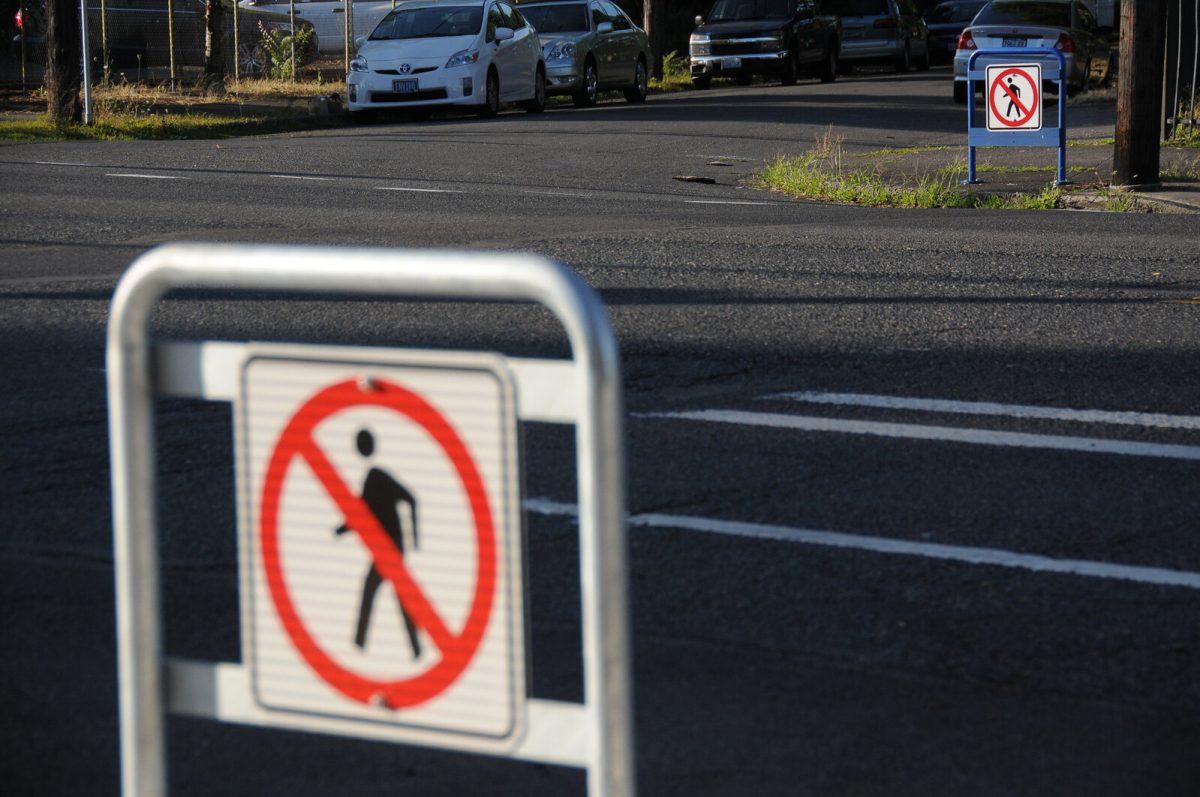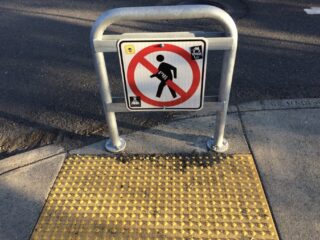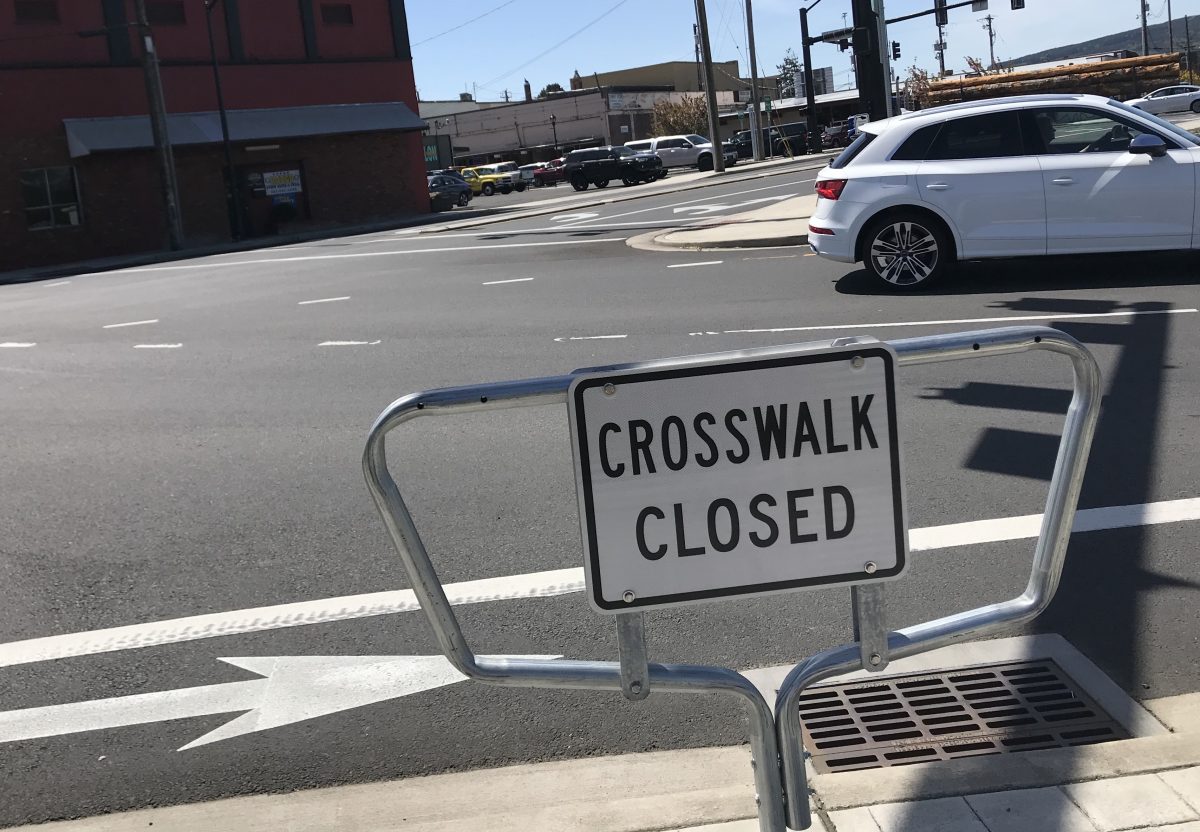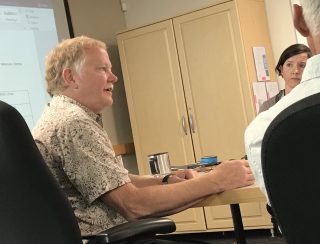
(Photo: J. Maus/BikePortland)
This post is part of an ongoing look at crosswalk closures. It was written by contributor Catie Gould and Jonathan Maus and edited by Emily Guise.
“They’re allowed to do it. Whether it’s a good idea for the community or the right application is another issue.”
— Scott Kocher, lawyer
As we reported last month, readers have been noticing “No Crossing” signs all over town. The signs are being erected by both the City of Portland (a newly-crowned Platinum Walk Friendly City) and Oregon Department of Transportation.
In Oregon we’ve had it drilled into our heads that “every intersection is a crosswalk.” It turns out that’s not exactly true. With each new pair of these signs that go up, we lose another legal crosswalk. Given how important crosswalks are to a safe transportation system we’ve been trying to learn more about the policy impetus and practical impacts of these closures. For this post we asked active transportation advocates and personal injury lawyers Scott Kocher and Ray Thomas (both of whom are financial and content contributors to BikePortland) for their thoughts on the legal ramifications.
First, some background on the signs themselves. According to the FHWA’s Manual on Uniform Traffic Control Devices (MUTCD), the “No Crossing” sign in question is categorized as a “Selective User Exclusion” sign. These are used to give notice to road users that state or local statutes or ordinances exclude designated types of traffic from using particular roadways or facilities.
So from a technical standpoint, the signs are legit. But there’s more the this issue than meets the eye.
“They’re allowed to do it,” said Scott Kocher, who’s most upset about the closed crosswalk near the food carts on SE Hawthorne and 12th. “Whether it’s a good idea for the community or the right application is another issue.” Then there’s how the signs impact a person’s culpability in a collision. “If a person is injured in those crossings and calls a lawyer,” Kocher adds, “the lawyer wouldn’t take the case because there isn’t a viable legal claim since the pedestrian was at fault.”
Advertisement
“Historically, a lot of the decisions made around when we put in pedestrian crossing facilities and when we don’t, were made around motor vehicles. But for the last few years we’ve challenged that.”
— Mike Kimlinger, ODOT
Ray Thomas pointed out a “No Crossing” sign erected on Southwest 2nd Avenue near the Morrison Bridge. “It’s a real tough place to make a safe crosswalk, but people have the legal authority to do it,” he explained. “What you’ve got to do is to start back before that, and say, ‘What were all these places?’ They’re all the public way. The public way is what we, the public, have a right to and these are open to us. And when the government or a private party takes it away, they’d better have a pretty darn good reason for doing it.” For Thomas, things like parking or vehicle throughput aren’t good reasons.

(Photo: Catie Gould)
We’ve heard different justifications for the signs from PBOT and ODOT. PBOT has said they’ll install “No Crossing” signs when there’s a corner that’s matched by something “that restricts free movement” (like a parked car or bioswale) on the opposite corner. They’ve also said crossings are closed when they’re deemed too unsafe due to the presence of multi-lane roads with high speeds and/or high volumes of traffic. They’re also more likely to cross one crossing if there’s a safer place to cross nearby.
ODOT says they still haven’t developed standardized guidelines for the practice. And the public has no input on closure decisions. ODOT State Traffic Roadway Engineer Mike Kimlinger told the Oregon Bicycle and Pedestrian Advisory Committee (OBPAC) at their meeting on August 14th that he’s been closing about two crosswalks per month. So far, the final closure decisions rest solely with himself and State Traffic Engineer Bob Pappe. “We try to not close very many,” he told the committee. “But there are places where it’s probably not a good idea for people to be. The interaction between a three or four thousand pound vehicle — even if it’s going 25 or 30 mph — is not good if they can’t be seen or if they’re unexpected.”

(Photo: J. Maus/BikePortland)

(Photo: J. Maus/BikePortland)
When a committee member voiced concerns that motor vehicle flow is often prioritized over walkers in these situations, Kimlinger agreed. “Yes, historically, a lot of the decisions made around when we put in pedestrian crossing facilities and when we don’t, were made around motor vehicles,” he said. “But for the last few years we’ve challenged that.” Kimlinger said he’s had “many conversations” with Region 1 (Portland) staff about crosswalk closure decisions.
The way Kimlinger sees it (which would likely be the same for the City of Portland), the presence of these signs changes the legal standing of the crossing. Asked by a committee member if it would be legal to cross where a “Crosswalk Closed” sign had been installed, Kimlinger replied, “You can legally cross there, as long as you give right-of-way to every other user. You don’t have enhanced right-of-way as you would in a crosswalk… If something happened it would be their fault.”
Government entities have broad authority to define legal road use and neither lawyer we spoke to for this story could think of any cases that have challenged it. “It would take a huge amount of legal effort and a special case to challenge this,” Kocher said.
“It’s almost like they’re making us trespassers on our own crosswalk.”
— Ray Thomas, lawyer
“I don’t think that PBOT or ODOT is giving sufficient weight to the fact that what they’re doing is infringing upon our right to roam, to be in the public way,” Thomas said. “It’s almost like they’re making us trespassers on our own crosswalk.”
What about people with disabilities? In recent years, walking advocates have been racking up legal victories under the Americans with Disabilities Act (ADA). In 2016, a lawsuit against the Oregon Department of Transportation (ODOT) that alleged the agency had failed to install adequate curb ramps as part of its highway construction and maintenance projects as required under the ADA, was settled when ODOT agreed to fix all non-compliant curb ramps by 2027. At the recent OBPAC meeting, ODOT said they completed 663 curb ramps last year and have 27,327 ramps remaining to fix statewide.
A similar lawsuit was brought against the Portland Bureau of Transportation (PBOT) and it settled in September 2018. Under terms of the suit PBOT must build 1500 ramps per year for the next twelve years, doubling the pace they were built from 2010-2015. Additionally, PBOT is required to upgrade or install new curb ramps whenever sidewalks are reconstructed, as long as people are permitted to cross there.
Which leads to another question: Are these agencies closing crosswalks because it’s cheaper than making them ADA compliant? “If there was a single case of closing a crosswalk instead of adding an ADA ramp,” Kocher mused, “I think that would raise an eyebrow with the judge.”
— Catie Gould, @Citizen_Cate on Twitter
Never miss a story. Sign-up for the daily BP Headlines email.
BikePortland needs your support.

